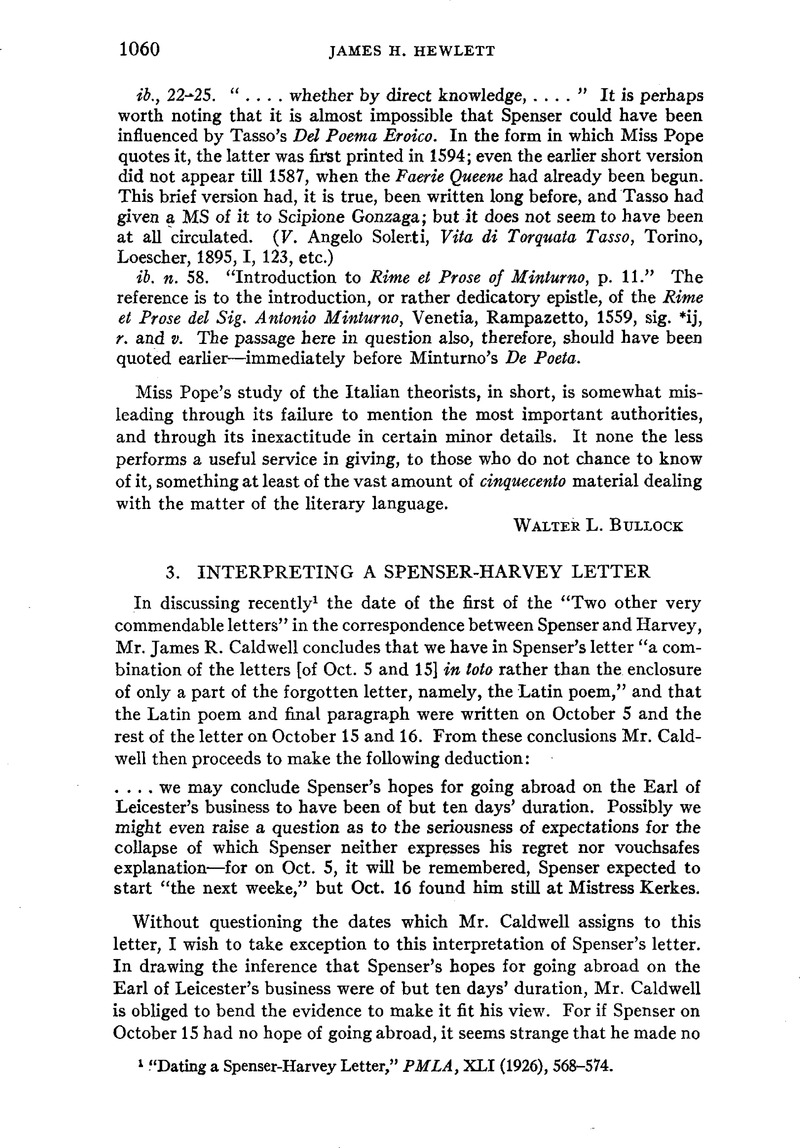Article contents
Interpreting a Spenser-Harvey Letter
Published online by Cambridge University Press: 14 December 2021
Abstract

- Type
- Comment And Criticism
- Information
- Copyright
- Copyright © Modern Language Association of America, 1927
References
1 “Dating a Spenser-Harvey Letter,” PMLA, XLI (1926), 568–574.
2 An excellent history of this period is given in Conyers Read's Mr. Secretary Walsingham and the Policy of Queen Elizabeth, II, 1–117. The real crisis came in October, 1579. From Oct. 2 to Oct. 8 the Council was in daily session considering the marriage problem. Elizabeth was hard to satisfy and made a solution apparently impossible. On Oct. 25 the Council was again in session to consider the same problem and seemed no nearer a solution than before. Alençon came in October and did not leave till February.
3 See Batfidd Papers, Pt. 2, pp. 272–273. For other instances of characteristic delays during this period or references to them, see Cal. State Papers, Foreign, 1578–79, pp. 35, 121 f., 129 f., 138, 402. For characteristic delays during the whole of Elizabeth's reign see Letters Written by John Chamberlain (Cam. Soc. Pub. No. 79): Letters 12–14, 16–18; also Fox Bourne, Sir Philip Sidney (New York, 1893), pp. 250–51; and Julian S. Corbett, Drake and the Tudor Navy, II, 9 f., 11, 117–24, 255, 298–99. Many other illustrations could be found.
4 Cal. State Papers, Foreign, 1579–80, p. 86. Does “to conclude the matter there” refer to the terms of marriage between Elizabeth and Alençon?
5 Acts of Privy Council, 11, 1578–80
6 Harvey's letter, dated Oct. 23, 1579, is in Gro'sart's The Works of Gabriel Harvey, I, 20–27. Whatever attitude one may take regarding the spirit in which this letter is written, I believe he must admit that Harvey assumed Spenser had plans to leave England and still expected to go when he finished his letter on Oct. 15 and 16.
7 Mr. Moore Smith has pointed out (Marginalia, p. 21) that Harvey may have been selected to accompany one of the deputies Elizabeth chose to attend a conference of German Protestant princes which was to have been held at Schmalkalden on June 7, 1578. These deputies were appointed May 15 (Cal. State Papers, Foreign, 1577–78, p. 686). After much uncertainty and a delay of more than a month apparently, the journey was broken off (Cal. Stale Papers, Foreign, 1578–79, p. 35). Also in the Epilogue of the second part of his Gratulationis Valdenensis Harvey makes Leicester say that he had planned to send Harvey into France and Italy (Grosart, op. cit., p. xxxix). So Harvey may have had at least two experiences when his plans to visit the continent were not carried out.
8 Such, for example, as Miss Clare Howard gives in English Travellers of the Renaissance (New York, 1914), especially in chapters 2–4.
9 Besides Homer's Odyssey and Virgil's Æneid, both of which were considered important for the Renaissance traveller, Harvey mentions two very authoritative works on travel—Jerome Turler's The Traveler, translated into English and published in London in 1575, and Theodor Zwinger's Methodus Apodemica (Basel, 1577).
10 A good example of such a letter is Philip Sidney's to his brother Robert (Steuart A. Pear's The Correspondence of Sir Philip Sidney and Hubert Languet, 195–298), who went abroad in February, 1579, the same year Spenser planned to go. Sidney advises Robert to travel profitably: “I am sure you have imprinted in your mind the scope and mark you mean by your pains to shoot at; for if you should travel but to travel, or to say you have travelled, certainly you should prove a pilgrim to no purpose.” It is of special interest to note that Sidney refers to Ulysses, declaring that “who rightly travels with the eye of Ulysses, doth take one of the most excellent ways of worldly wisdom.” He also warns against certain dangers. A few years before (May, 1573) when he went abroad, Sidney himself had received the same timely advice from Languet (Ibid., p. 85, also pp. 12, 41, 51, 52). Other letters containing similar advice can be found in the correspondence of Lord Burghley, Fulke Greville, the Earl of Essex, and Secretary Davison. See Howard, op. cit., p. 35 and passim.
11 There are many references to Ulysses as the wise traveller and to Circe as a most dangerous influence.
12 Translated by Gordon Laing in F. I. Carpenter's A Reference Guide to Edmund Spenser (Chicago, 1923), pp. 57–58.
13 “Spenser and the Earl of Leicester,” PMLA, XXV (1910) 537–538.
14 Quoted by Caldwell, op. cit., p. 572.
- 1
- Cited by




